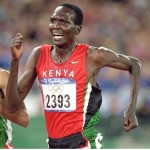So you’re looking to lose fat. Great – that makes you and hundreds of other people out there who are trying to win the battle of the bulge.
But, are you like the hundreds of other people who make the following vital mistake as they go about their fat loss goals?
As soon as someone sets the goal that they want to incinerate body fat, the first thing they think is, ‘I gotta burn calories’.
After all, it’s the basic equation of calories in versus calories out that will determine whether fat loss takes place. Sure, there are some other factors that do go into the mix that will establish how quickly you lose weight and whether or not the weight is fat (good) or muscle (bad), but overall, that’s the bottom line.
Eat more than you burn and you’re facing an uphill battle.
Burn more than you eat and B-I-N-G-O, you’re on the road to success.
This thought process is precisely what leads them into the biggest fat loss mistake that so many people make today.
What’s the mistake?
High rep training.
Let me explain.
The Premise Of High Rep Training For Fat Loss
As soon as you get into the ‘burn-baby-burn’ mindset in hopes of shedding that stubborn layer of body fat, two things often happen.
- You decrease your calorie intake significantly. The less food coming in, typically the faster you’ll lose weight.
- You increase your activity level dramatically. The more calories you burn, the faster you’ll lose weight.
Seems like it would make sense, right?
The problem here is that in doing so, you’re sending your body into shock. The simultaneous slash to your food intake and ramp up of your exercise levels essentially cause it to think a famine is at play. You’re starving and you’re asking your body to complete hours and hours of exercise – both cardio and weight lifting.
Trouble is around the corner.
The high rep protocol comes in as people start to think that this is a very fast way to burn extra calories. If you do 6 reps, 10 reps must be better.
In addition to upping the reps, often the sets get increased as well. Whereas you used to do 3 sets for bench press, now you’re doing five. You want to maximize the fat loss that session produces.
Due to the fact that you are increasing the reps along with the sets, it only stands to reason that the weight must come down. Something has to give and there is an inverse relationship between total weight lifted and sets performed.
This is normal and natural – and, there’s no way of getting around it.
So what used to be a full body workout session that looked like this:
Bench Press – 3 sets of 8 reps
Squats – 3 sets of 8 reps
Barbell rows – 3 sets of 8 reps
Shoulder Press – 3 sets of 8 reps
Lunges – 2 sets of 10 reps
Bicep curls – 2 sets of 10 reps
Tricep Extensions – 2 sets of 10 reps
Calf Raises – 2 sets of 10 reps
Now becomes this:
Bench Press – 5 sets of 12 reps
Squats – 5 sets of 10 reps
Barbell rows – 5 sets of 12 reps
Shoulder Press – 4 sets of 12 reps
Lunges – 3 sets of 20 reps
Leg Extension – 3 sets of 15 reps
Hamstring Curl – 3 sets of 15 reps
Bicep curls – 2 sets of 20 reps
Tricep Extensions – 2 sets of 20 reps
Lateral Raises – 2 sets of 20 reps
Front raises – 2 sets of 20 reps
Calf Raises – 2 sets of 10 reps
I’m tired just looking at that. But yet, for those doing full body workouts trying to lose fat, this is often what their routine will consist of. Or, they may decide a body part split is more appropriate so that they can lift weights six (yes, you read that right, six) days per week. That is not appropriate.
The Problem With High-Rep, High Volume Training
To help you understand why this is such a vital mistake when seeking fat loss, I want you to think for a second what the three main requirements are to build muscle.
They are:
- An overloading stimulus, usually in the form of more weight.
- Sufficient rest to allow for the recovery process to take place (keep in mind more work performed will demand longer rest periods)
- An abundance of calories to support the growth process.
Most people have a fairly good grasp over this. Basically, lift heavy, rest, eat, and grow.
Now for fat loss, #3 is obviously removed. There’s no way of eating more than you burn if you hope to lose fat off your body. It’s just not gonna happen.
Wouldn’t it now stand to reason that the exact things that built that muscle in the first place are also the things that will help you maintain that muscle mass?
And, isn’t the goal when dieting to maintain as much muscle mass as possible so that you’re losing just fat mass, not muscle? After all, your muscle tissue is what gives you that definition you seek and what also burns the most calories at rest so you can maintain an elevated metabolic rate.
So why would you do something that caused you to lighten how much weight you were lifting? All you’re going to do is end up looking like this guy… 
Without that overloading stimulus, what reason are you giving your muscles to maintain themselves?
In your body’s eye’s, all it sees is that it doesn’t need to be as strong to perform the work you’re asking of it, therefore it’s going to get rid of the most costly tissue to maintain – that muscle.
When dieting, your body wants to get rid of muscle. If it had its preference, it would hold onto fat and burn only muscle. Fat is what keeps it alive. Fat is it’s storage of energy for survival. Your muscle mass is just burning up precious calories that you’re going to replace with your food intake.
So by shifting to the higher rep protocol, you’re basically sending the message to the body that it can reduce the amount of muscle it has since it won’t be required to lift as heavy of loads.
Is that what you’re going for?
Now, there can be a time and place for higher rep training. Depletion workouts can be beneficial for fat loss purposes but that’s a whole other topic for another day. Some higher rep training can sometimes be used for isolation exercises as well at the end of the workout, but then one could argue over the fact as to why are you doing isolation exercises in the first place when your recovery is limited?
When dieting, volume needs to come down. You are taking in less fuel than your body would like to be and therefore it has fewer resources to recover with.
Why would you increase the volume putting more stress on the body that it then has to deal with?
Again, it’s just a bad move.
So what’s the solution to avoid this common workout mistake that’s really sacrificing your results when facing fat loss?
Maintain your heavy weight lifting exercises and used a reduced volume protocol. Basically, do the opposite of what your natural instincts tell you (if you’re 75% of the population out there).
That is what will get you results.

